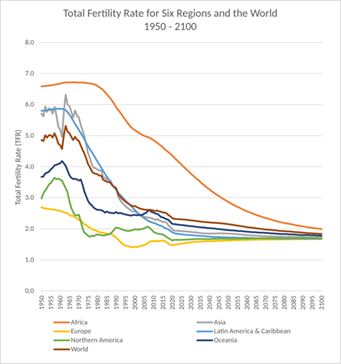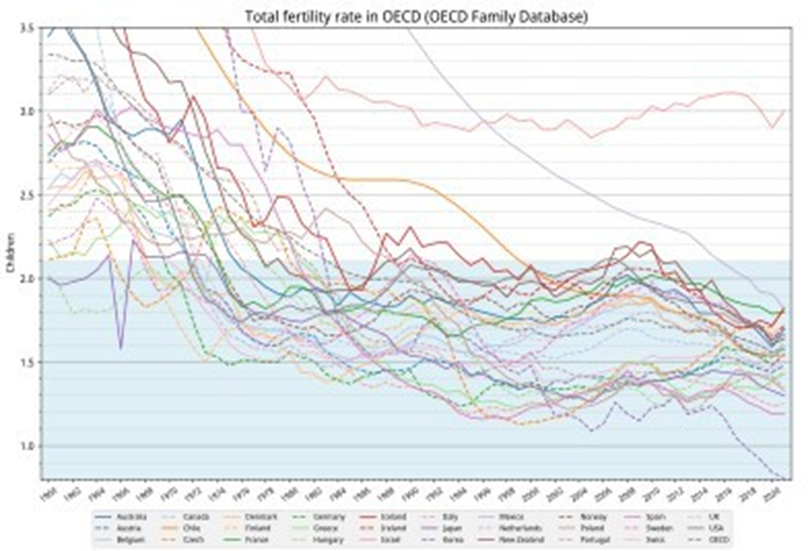Global Decline in Fertility Rates
Global Decline in Fertility Rates
Dr. Shilpa Agne1*, Sawanya Agne2
1) Dr.Shilpa Agne , Speciality Doctor Obstetrics and Gynaecology, Warwick Hospital , UK
2) Miss Sawanya Agne - Pre medicine student, Buckinghamshire University, UK.
*Correspondence to: Dr. Shilpa Agne, Speciality Doctor Obstetrics and Gynaecology, Warwick Hospital, UK.
Copyright
© 2024 Dr. Shilpa Agne. This is an open access article distributed under the Creative Commons Attribution License, which permits unrestricted use, distribution, and reproduction in any medium, provided the original work is properly cited.
Received: 11 November 2024
Published: 19 November 2024
DOI: https://doi.org/10.5281/zenodo.14185610
Abstract
Introduction: Fertility Rates refer to the number of babies born to a woman in her life within a specific population. In this article, fertility rates across different countries will be compared, examining various factors such as birth rates, health, family planning, and others. The causes and effects of the decline in fertility rates will be examined in detail, along with potential solutions and future predictions.
Objective: To determine the reasons behind the decline in fertility rates on a global scale.
Study Design: Online Research
Keywords: Replacement Level; Demographic Shift.
Abbreviations: Total Fertility Rate (TFR).
Global Decline in Fertility Rates
Introduction
Total Fertility Rate is defined as the number of babies born in a population, to a woman from her birth to her death. Fertility rate cannot be confused with Birth Rate as Birth Rate refers to the number of babies born within a specific population over a defined period, which is not specific to women or women of specific age groups. Today, half of the world’s countries have fertility rates below the replacement level. Excluding migration effects many nations are expected to see a population decline of more than 50% between 2017 and 2100, leading to substantial demographic shifts with significant societal impacts. TFR is a standard demographic indicator used globally to maintain a stable population, assuming there is no net migration and stable mortality rates, a total fertility rate of 2.1 children per woman, i.e. 2.1 births per woman is favourable and ensures stability. Fertility, mortality, and migration influence population growth and mirror the economic and social changes within a society. [1]
Historical Context
From around 10,000 BC until the onset of the Industrial Revolution, fertility rated worldwide were high by modern standards. The Industrial Revolution, beginning around 1800 AD, marked the start of the demographic transition, which led to a sustained decline in the TFR across almost every region, a trend that continues into the 21st century.
Before 1800, all societies were subject to what is known as the Malthusian Trap, wherein improvements in living standards could only occur through increased mortality (due to wars, plagues, and famines) or reduced birth rates. Child mortality was extremely high, often reaching 50%, necessitating high fertility rates to ensure enough workers, male heirs, and caregivers for the elderly. Fertility rates in Europe, for instance, ranged from 4.5 in Scandinavia to 6.2 in Belgium, before 1800; The United States stood at 7.0. Despite these high fertility rates, global population growth was slow, around 0.04% per year, largely due to high mortality rates and slow increases in food production.
From 1800 to 1950, the Industrial Revolution, especially in Great Britain, continental Europe, and the United States, initiated the demographic transition. This period saw a decline in mortality rates due to advances in public sanitation, personal hygiene, and food supply, which reduced the frequency of famines. The reduction in child mortality, combined with significant societal changes such as urbanization, led to a decrease in fertility rates, as there was less need to have many children.
The correlation between child mortality and fertility rates in the United States offered a compelling example. In 1800, the child mortality rate in the US was 33%, indicating that one-third of all children born would not survive until their fifth birthday. Concurrently, the TFR was 7.0, meaning that on average, a woman would have seven children over her lifetime. By 1900, child mortality had decreased to 23%, a reduction of nearly one-third, and the total fertility rate had declined to 3.9, representing a 44% reduction. In 1950, child mortality had significantly declined to 4%, an 84% decrease, with the TFR further reducing to 3.2. By 2018, child mortality had fallen to 0.6%, and the TFR had decreased to 1.9, below the replacement level.
Fig 1
The chart indicates that the decline in the TFR since the 1960s has been observed in every region of the world. This global TFR is projected to continue decreasing throughout the remainder of the century, reaching a below-replacement level of 1.8 by 2100.
As of 2021, the global TFR is 2.3. Since the global fertility replacement rate for the period 2010-2015 has been estimated at 2.3, humanity has reached or is nearing a significant milestone where the fertility rate matches the replacement rate.
From 1950 to the present, and as projected into the future, the demographic transition has spread worldwide. The data indicates that since 1965, the global TFR has been in continuous decline, a trend that persists into the 21st century. [2]
|
WORLD HISTORICAL TRF (1950- 2020) |
|
|
Years |
Global Average |
|
1950-1955 |
4.86 |
|
1955-1960 |
5.01 |
|
1960-1965 |
4.70 |
|
1965-1970 |
5.08 |
|
1970-1975 |
4.83 |
|
1975-1980 |
4.08 |
|
1980-1985 |
3.75 |
|
1985-1990 |
3.52 |
|
1990-1995 |
3.31 |
|
1995-2000 |
2.88 |
|
2000-2005 |
2.73 |
|
2005-2010 |
2.62 |
|
2010-2015 |
2.59 |
|
2015-2020 |
2.52 |
|
2020-2025 |
2.35 |
Current Trends and Statistics
Some of the trends and statistics have been noted below.
Eastern Asia
Eastern Asia includes regions with some of the lowest fertility rates in the world. Hong Kong, Macau, Singapore, South Korea, And Taiwan have very low fertility rates, defined as a TFR of 1.3 or below. Macau’s TFR was below 1.0 in 2004. North Korea has the highest TFR in East Asia at 1.95.
China
China’s TFR was 1.09 in 2022. The country implemented a one-child policy in January 1979 to control its rapidly growing population. This policy was replaced by a two-child policy in January 2016 and later by a three-child policy in July 2021 in response to the country’s rapidly ageing population.
Japan
Japan had a TFR of 1.26 in 2022. The country is experiencing rapid population ageing
due to both a high life expectancy and a low birth rate. Japan’s population is shrinking, having lost 430,000 people in 2018, reducing the total population to 126.4 million. Unlike Hong Kong and Singapore, which mitigate demographic challenges through immigrant workers, Japan faces a significant demographic imbalance due to its restrictive immigration policies.

Fig 2
South Korea
South Korea is grappling with a low birth rate, one of its most pressing socio-economic challenges. Factors contributing to this include rising housing costs, limited job opportunities for younger generations, and insufficient support for families with newborns. In 2019, the TFR fell to 0.92. Despite numerous initiatives in the past decade, such as subsidizing childcare costs and prioritizing public rental housing for families with more children, the birthrate remains low. As of 2022, South Korea had the world’s lowest TFR at 0.78, with Seoul’s TFR at 0.57.
Southern Asia
Bangladesh
Bangladesh has seen a significant decline in fertility rates, dropping from 6.8 in the period 1970-1975 to 2.0 in 2020, over approximately two generations.
India
India has also experienced a marked decrease in fertility rates over the early 21st century. The TFR fell from 5.2 in 1971 to 2.2 in 2018. Recent surveys indicate that the TFR further declined to 2.0 in 2019-2020, marking the first time it has fallen below the replacement level.
Iran
During the Iranian calendar year from March 2019 to March 2020, Iran’s TFR fell to 1.8.
Western Asia
In 2019, Turkey’s TFR was recorded at 1.88.
Europe
The average TFR in the European Union (EU-27) was 1.53 children per woman in 2021. Among EU countries, France had the highest TFR at 1.84, followed by Czechia (1.83), Romania (1.81), Ireland (1.78), and Denmark (1.72). Malta had the lowest TFR at 1.13. Other Southern European countries also had very low TFRs, including Portugal (1.39), Greece (1.43), Spain (1.19), and Italy (1.25). The United Kingdom’s TFR was
1.53 in 2021. Among non-EU European post-Soviet states, Russia had a TFR of 1.60, Moldova 1.59, Ukraine 1.57, and Belarus 1.52. The emigration of young adults from Eastern Europe to Western Europe exacerbates demographic issues in countries such as Bulgaria, Moldova, Romania, and Ukraine.
Latin America and the Caribbean
In 2023, Brazil, the most populous country in the region, had an estimated TFR of 1.75. Mexico, the second most populous country, had an estimated TFR of 1.73. The next four most populous countries in the region had TFRs between 1.9 and 2.2: Colombia (1.94), Argentina (2.17), Peru (2.18), and Venezuela (2.20). Belize had the highest estimated TFR in the region at 2.59, while Puerto Rico had the lowest at 1.25. [2]
Fig 3
*The Organization for Economic Cooperation and Development (OECD)
Factors for Declining Fertility Rates
1) Lower Child Mortality
Historically, high child mortality rates, including infant deaths and deaths due to early childhood illnesses, contributed to higher fertility rates as families compensated for the loss of children. As child mortality rates have significantly decreased in many countries, a corresponding decline in fertility rates has been observed.
2) Improved Educational Opportunities for Women
The social empowerment of women, particularly through enhanced educational opportunities, has a significant impact on reducing fertility rates, as mentioned in the ‘Our World in Data’ project done by Oxford University. Education not only directly lowers fertility rates but also positively influences other contributing reasons, i.e. increased use of contraception, improved childhood health outcomes, and greater female participation in the workforce.
3) Increasing Societal Prosperity
According to U.S. News and World Report, high-income countries have seen a more pronounced decline in fertility rates compared to low-income countries. However, this is unclear whether this correlation is due to confounding factors such as increased educational opportunities. The World Bank indicates that higher levels of education are associated with greater societal prosperity and lower fertility rates. Additionally, Our World in Data suggests that other reasons, such as career aspirations and evolving cultural norms around marriage, might also influence the decision to have fewer children or remain childless. Many individuals in wealthier regions are delaying marriage, prioritizing careers, and opting to have children later in life, as noted by The Week.
4) Better Access to Contraception and Family Planning Advice
The most pronounced downfalls in fertility rates have been associated with the introduction of safe and reliable access to contraception, in several regions. This includes ensuring confidential access when cultural norms or familiar opposition may restrict a woman’s ability to obtain birth control. The increased availability of sexual health education and family planning resources has also contributed to the reduction in fertility rates.
The reduction in TFR, alongside the ageing population and a shrinking number of younger workers, raises concerns among analysts about potential adverse effects on economic growth that may be challenging to mitigate. Initially, a decrease in birth rates can stimulate economic growth. However, once a critical threshold and fertility rates continue to decline, the disparity between the elderly and the
working-age population may become unsustainable. While a reduction in population growth might have positive environmental implications, the specific outcomes remain uncertain. Economists and population experts have yet to fully comprehend the broader social and economic impacts of these demographic shifts. [3]
Consequences of the Decreasing Fertility Rates
1) Statistical Shift and Aging Population
A higher proportion of elderly individuals compared to the working-age population is a result of the ageing population, which, in turn, is a result of falling Fertility Rates. This situation puts a strain on the healthcare system, social services, and pension schemes. [4]
2) Economic Growth and Labor Market
A shrinking workforce due to low fertility rates hampers economic growth and productivity. The reduced number of workers limits economic development and innovative potential. [5], [4]
3) Socioeconomic and Cultural Changes
Cultural shifts towards individualism and materialism lead to changing family values, such as reduced emphasis on marriage and larger families. These cultural dynamics further reinforce low fertility trends. [6]
4) Policy Responses and Challenges
Pronatalist policies, including economic incentives and restrictions on fertility control, have had limited success in reversing declining fertility rates. Successful policy interventions require a nuanced understanding of changing cultural and socioeconomic factors. [6]
5) Long-term Genetic and Health Implications
Persistent low fertility rates may have long-term biological consequences, including a lack of selection pressure for high fertility genotypes and potential impacts from reproductive toxicants in modern environments. [7]
Conclusion
To summarize, TFR is a metric representing the average number of children born per woman, which aggregates fertility rates across all age groups for a specific year.
Historically, fertility rates ranged from 4.5 to 7 children per woman in premodern societies. High infant and child mortality rates constrained population growth during that period. As advancements in health care reduced mortality rates, population growth accelerated. However, the global average fertility rate has decreased significantly, from approximately 5.0 in the 1960s to around 2.4 in 2021. This decline in Fertility rates signifies the cessation of rapid population growth.
References
[1]- Bart C J M Fauser, G David Adamson, Jacky Boivin, Georgina M
Chambers, Christian de Geyter, Silke Dyer, Marcia C Inhorn, Lone Schmidt, Gamal I Serour, Basil Tarlatzis, and Fernando Zegers-Hochschild, Contributors and members of the
IFFS Demographics and Access to Care Review Board, Human Reproduction Update, Volume 30, Issue 2, March-April 2024, Pages 153–173 https://academic.oup.com/humupd/article/30/2/153/7513427?login=false
[2]https://en.wikipedia.org/wiki/Total_fertility_rate#:~:text=The%20total%20fertility%20r ate%20(TFR,end%20of%20their%20reproductive%20life.
[3] GE HealthCare
https://www.volusonclub.net/empowered-womens-health/4-contributing-factors-todeclining- fertility-rates-a-global-overview/
[4] Wu, Y., Su, B., & Li, J. (2023). The Impact of Low Fertility Rates on Labor Demand and Socioeconomic Development in China. China CDC Weekly.
[5] Duggal, M., & Kaur, T.P. (2022). Low-fertility trap: a threat to India’s agile workforce. International Journal of Economic Policy in Emerging Economics, [4] Wu, Y., Su, B., & Li, J. (2023). The Impact of Low Fertility Rates on Labour Demand and Socioeconomic Development in China. China CDC Weekly.
[6] Erfani, A. (2019). Policy implications of cultural shifts and enduring low fertility in Iran.
[7] Aitken, R. J. (2024). Population decline: where demography, social science and biology intersect, Reproduction..

Figure 1

Figure 2

Figure 3
